Therapeutics in Nursing
VerifiedAdded on 2022/12/27
|17
|3834
|66
AI Summary
This document provides a review of Jame's medication chart, including the names of the medications, their uses, side effects, interactions, and nursing implications. It also discusses the mechanism of action of these medications. The document covers medications such as Aspirin, Metformin XR, Ramipril, Metoprolol, Potassium chloride, Pantoprazole, Atorvastatin, Oxycodone, Cefazolin, and Furosemide.
Contribute Materials
Your contribution can guide someone’s learning journey. Share your
documents today.
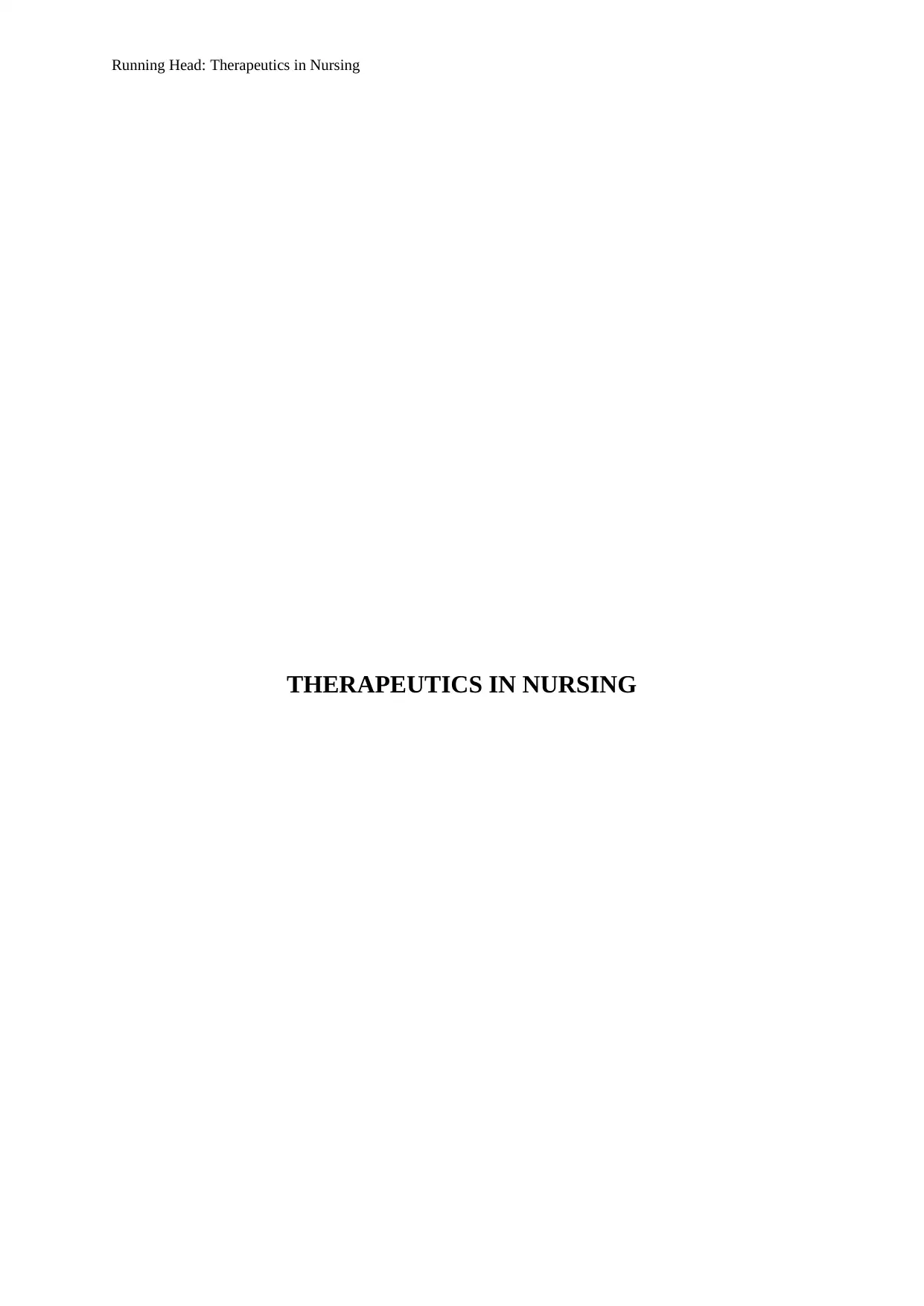
Running Head: Therapeutics in Nursing
THERAPEUTICS IN NURSING
THERAPEUTICS IN NURSING
Secure Best Marks with AI Grader
Need help grading? Try our AI Grader for instant feedback on your assignments.

2
Therapeutics in Nursing
Table of Contents
1. Reviewing Jame’s medication chart.......................................................................................3
2. Mechanism of action of medications...................................................................................10
Reference list............................................................................................................................15
Therapeutics in Nursing
Table of Contents
1. Reviewing Jame’s medication chart.......................................................................................3
2. Mechanism of action of medications...................................................................................10
Reference list............................................................................................................................15
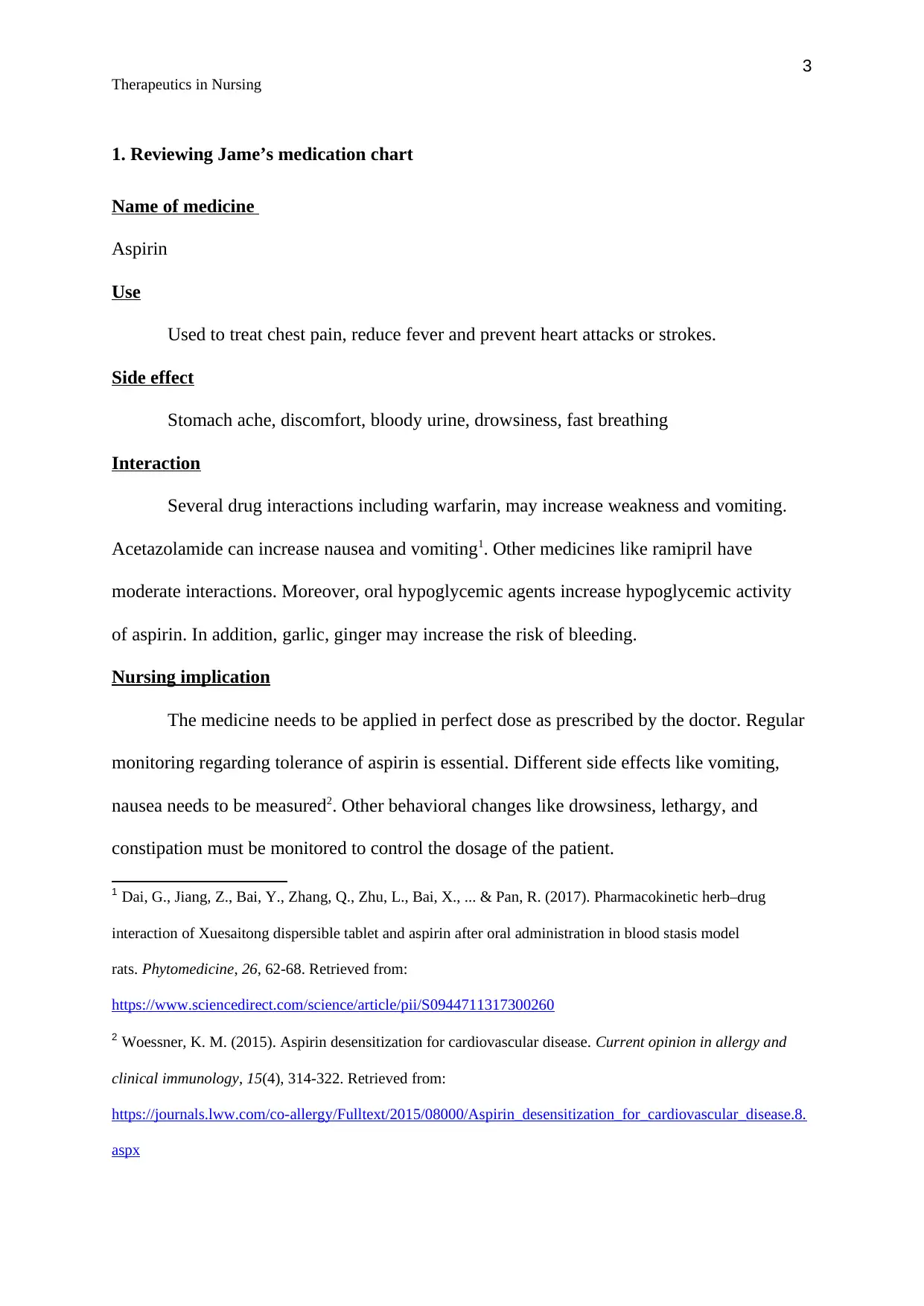
3
Therapeutics in Nursing
1. Reviewing Jame’s medication chart
Name of medicine
Aspirin
Use
Used to treat chest pain, reduce fever and prevent heart attacks or strokes.
Side effect
Stomach ache, discomfort, bloody urine, drowsiness, fast breathing
Interaction
Several drug interactions including warfarin, may increase weakness and vomiting.
Acetazolamide can increase nausea and vomiting1. Other medicines like ramipril have
moderate interactions. Moreover, oral hypoglycemic agents increase hypoglycemic activity
of aspirin. In addition, garlic, ginger may increase the risk of bleeding.
Nursing implication
The medicine needs to be applied in perfect dose as prescribed by the doctor. Regular
monitoring regarding tolerance of aspirin is essential. Different side effects like vomiting,
nausea needs to be measured2. Other behavioral changes like drowsiness, lethargy, and
constipation must be monitored to control the dosage of the patient.
1 Dai, G., Jiang, Z., Bai, Y., Zhang, Q., Zhu, L., Bai, X., ... & Pan, R. (2017). Pharmacokinetic herb–drug
interaction of Xuesaitong dispersible tablet and aspirin after oral administration in blood stasis model
rats. Phytomedicine, 26, 62-68. Retrieved from:
https://www.sciencedirect.com/science/article/pii/S0944711317300260
2 Woessner, K. M. (2015). Aspirin desensitization for cardiovascular disease. Current opinion in allergy and
clinical immunology, 15(4), 314-322. Retrieved from:
https://journals.lww.com/co-allergy/Fulltext/2015/08000/Aspirin_desensitization_for_cardiovascular_disease.8.
aspx
Therapeutics in Nursing
1. Reviewing Jame’s medication chart
Name of medicine
Aspirin
Use
Used to treat chest pain, reduce fever and prevent heart attacks or strokes.
Side effect
Stomach ache, discomfort, bloody urine, drowsiness, fast breathing
Interaction
Several drug interactions including warfarin, may increase weakness and vomiting.
Acetazolamide can increase nausea and vomiting1. Other medicines like ramipril have
moderate interactions. Moreover, oral hypoglycemic agents increase hypoglycemic activity
of aspirin. In addition, garlic, ginger may increase the risk of bleeding.
Nursing implication
The medicine needs to be applied in perfect dose as prescribed by the doctor. Regular
monitoring regarding tolerance of aspirin is essential. Different side effects like vomiting,
nausea needs to be measured2. Other behavioral changes like drowsiness, lethargy, and
constipation must be monitored to control the dosage of the patient.
1 Dai, G., Jiang, Z., Bai, Y., Zhang, Q., Zhu, L., Bai, X., ... & Pan, R. (2017). Pharmacokinetic herb–drug
interaction of Xuesaitong dispersible tablet and aspirin after oral administration in blood stasis model
rats. Phytomedicine, 26, 62-68. Retrieved from:
https://www.sciencedirect.com/science/article/pii/S0944711317300260
2 Woessner, K. M. (2015). Aspirin desensitization for cardiovascular disease. Current opinion in allergy and
clinical immunology, 15(4), 314-322. Retrieved from:
https://journals.lww.com/co-allergy/Fulltext/2015/08000/Aspirin_desensitization_for_cardiovascular_disease.8.
aspx
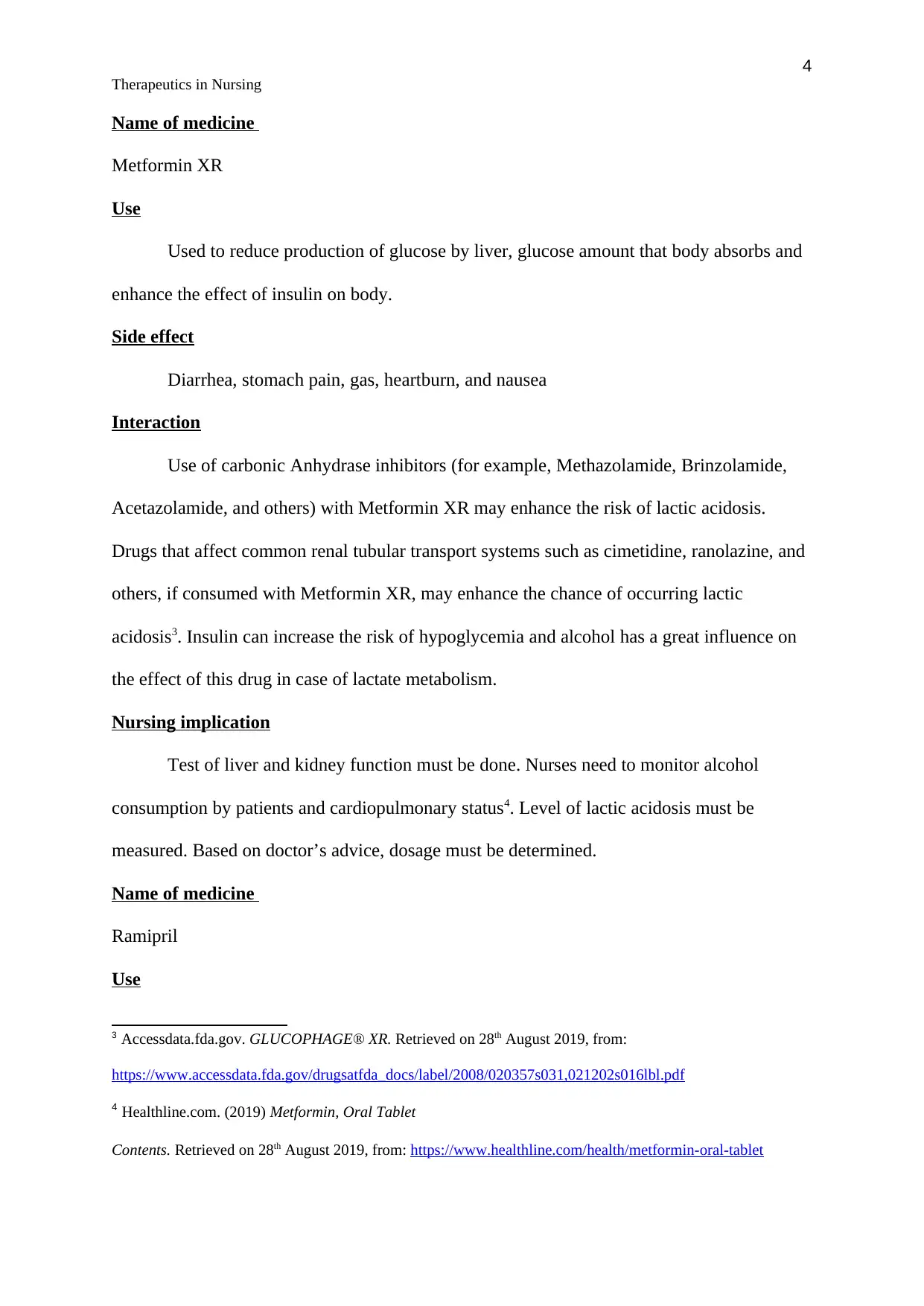
4
Therapeutics in Nursing
Name of medicine
Metformin XR
Use
Used to reduce production of glucose by liver, glucose amount that body absorbs and
enhance the effect of insulin on body.
Side effect
Diarrhea, stomach pain, gas, heartburn, and nausea
Interaction
Use of carbonic Anhydrase inhibitors (for example, Methazolamide, Brinzolamide,
Acetazolamide, and others) with Metformin XR may enhance the risk of lactic acidosis.
Drugs that affect common renal tubular transport systems such as cimetidine, ranolazine, and
others, if consumed with Metformin XR, may enhance the chance of occurring lactic
acidosis3. Insulin can increase the risk of hypoglycemia and alcohol has a great influence on
the effect of this drug in case of lactate metabolism.
Nursing implication
Test of liver and kidney function must be done. Nurses need to monitor alcohol
consumption by patients and cardiopulmonary status4. Level of lactic acidosis must be
measured. Based on doctor’s advice, dosage must be determined.
Name of medicine
Ramipril
Use
3 Accessdata.fda.gov. GLUCOPHAGE® XR. Retrieved on 28th August 2019, from:
https://www.accessdata.fda.gov/drugsatfda_docs/label/2008/020357s031,021202s016lbl.pdf
4 Healthline.com. (2019) Metformin, Oral Tablet
Contents. Retrieved on 28th August 2019, from: https://www.healthline.com/health/metformin-oral-tablet
Therapeutics in Nursing
Name of medicine
Metformin XR
Use
Used to reduce production of glucose by liver, glucose amount that body absorbs and
enhance the effect of insulin on body.
Side effect
Diarrhea, stomach pain, gas, heartburn, and nausea
Interaction
Use of carbonic Anhydrase inhibitors (for example, Methazolamide, Brinzolamide,
Acetazolamide, and others) with Metformin XR may enhance the risk of lactic acidosis.
Drugs that affect common renal tubular transport systems such as cimetidine, ranolazine, and
others, if consumed with Metformin XR, may enhance the chance of occurring lactic
acidosis3. Insulin can increase the risk of hypoglycemia and alcohol has a great influence on
the effect of this drug in case of lactate metabolism.
Nursing implication
Test of liver and kidney function must be done. Nurses need to monitor alcohol
consumption by patients and cardiopulmonary status4. Level of lactic acidosis must be
measured. Based on doctor’s advice, dosage must be determined.
Name of medicine
Ramipril
Use
3 Accessdata.fda.gov. GLUCOPHAGE® XR. Retrieved on 28th August 2019, from:
https://www.accessdata.fda.gov/drugsatfda_docs/label/2008/020357s031,021202s016lbl.pdf
4 Healthline.com. (2019) Metformin, Oral Tablet
Contents. Retrieved on 28th August 2019, from: https://www.healthline.com/health/metformin-oral-tablet
Secure Best Marks with AI Grader
Need help grading? Try our AI Grader for instant feedback on your assignments.
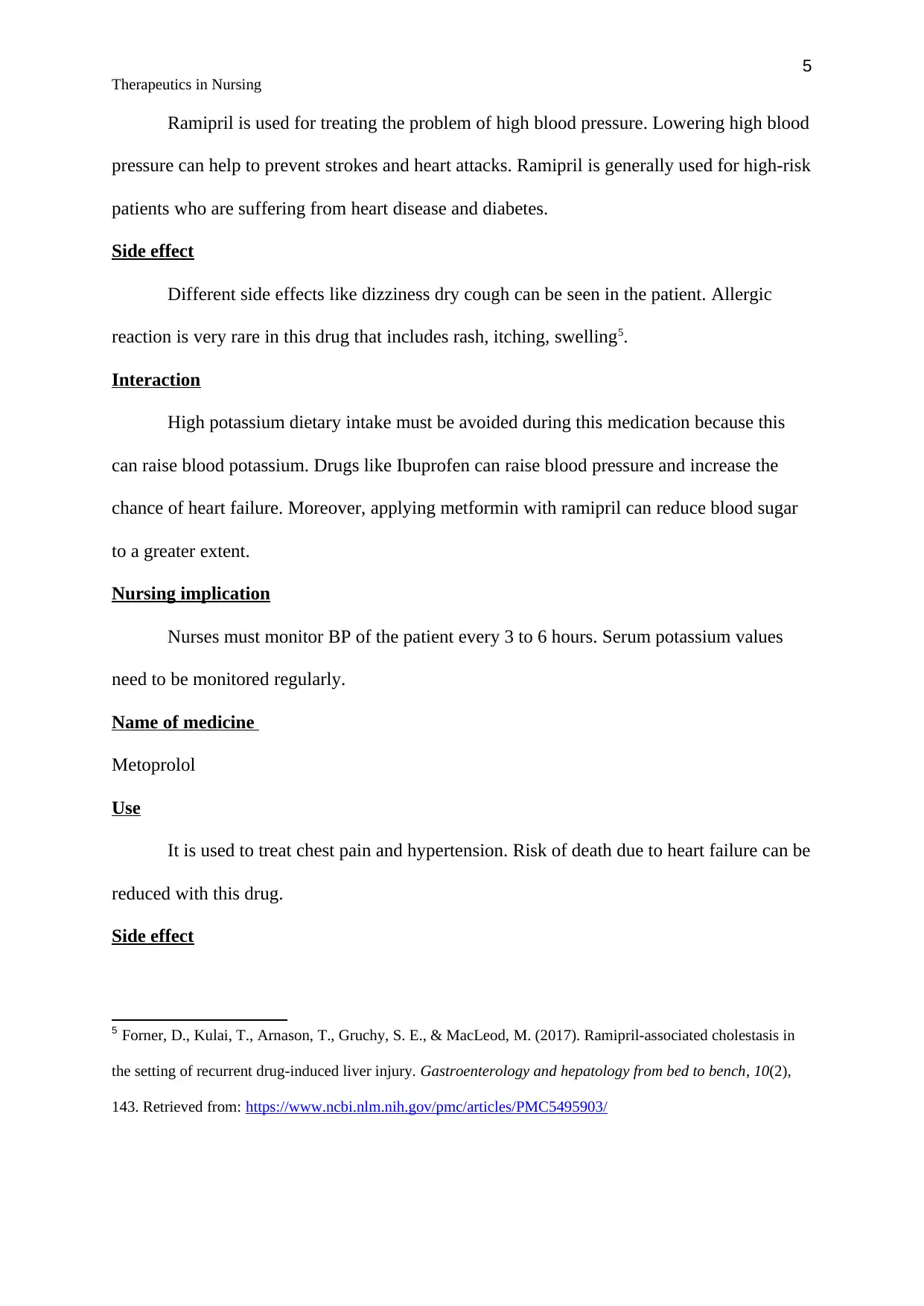
5
Therapeutics in Nursing
Ramipril is used for treating the problem of high blood pressure. Lowering high blood
pressure can help to prevent strokes and heart attacks. Ramipril is generally used for high-risk
patients who are suffering from heart disease and diabetes.
Side effect
Different side effects like dizziness dry cough can be seen in the patient. Allergic
reaction is very rare in this drug that includes rash, itching, swelling5.
Interaction
High potassium dietary intake must be avoided during this medication because this
can raise blood potassium. Drugs like Ibuprofen can raise blood pressure and increase the
chance of heart failure. Moreover, applying metformin with ramipril can reduce blood sugar
to a greater extent.
Nursing implication
Nurses must monitor BP of the patient every 3 to 6 hours. Serum potassium values
need to be monitored regularly.
Name of medicine
Metoprolol
Use
It is used to treat chest pain and hypertension. Risk of death due to heart failure can be
reduced with this drug.
Side effect
5 Forner, D., Kulai, T., Arnason, T., Gruchy, S. E., & MacLeod, M. (2017). Ramipril-associated cholestasis in
the setting of recurrent drug-induced liver injury. Gastroenterology and hepatology from bed to bench, 10(2),
143. Retrieved from: https://www.ncbi.nlm.nih.gov/pmc/articles/PMC5495903/
Therapeutics in Nursing
Ramipril is used for treating the problem of high blood pressure. Lowering high blood
pressure can help to prevent strokes and heart attacks. Ramipril is generally used for high-risk
patients who are suffering from heart disease and diabetes.
Side effect
Different side effects like dizziness dry cough can be seen in the patient. Allergic
reaction is very rare in this drug that includes rash, itching, swelling5.
Interaction
High potassium dietary intake must be avoided during this medication because this
can raise blood potassium. Drugs like Ibuprofen can raise blood pressure and increase the
chance of heart failure. Moreover, applying metformin with ramipril can reduce blood sugar
to a greater extent.
Nursing implication
Nurses must monitor BP of the patient every 3 to 6 hours. Serum potassium values
need to be monitored regularly.
Name of medicine
Metoprolol
Use
It is used to treat chest pain and hypertension. Risk of death due to heart failure can be
reduced with this drug.
Side effect
5 Forner, D., Kulai, T., Arnason, T., Gruchy, S. E., & MacLeod, M. (2017). Ramipril-associated cholestasis in
the setting of recurrent drug-induced liver injury. Gastroenterology and hepatology from bed to bench, 10(2),
143. Retrieved from: https://www.ncbi.nlm.nih.gov/pmc/articles/PMC5495903/
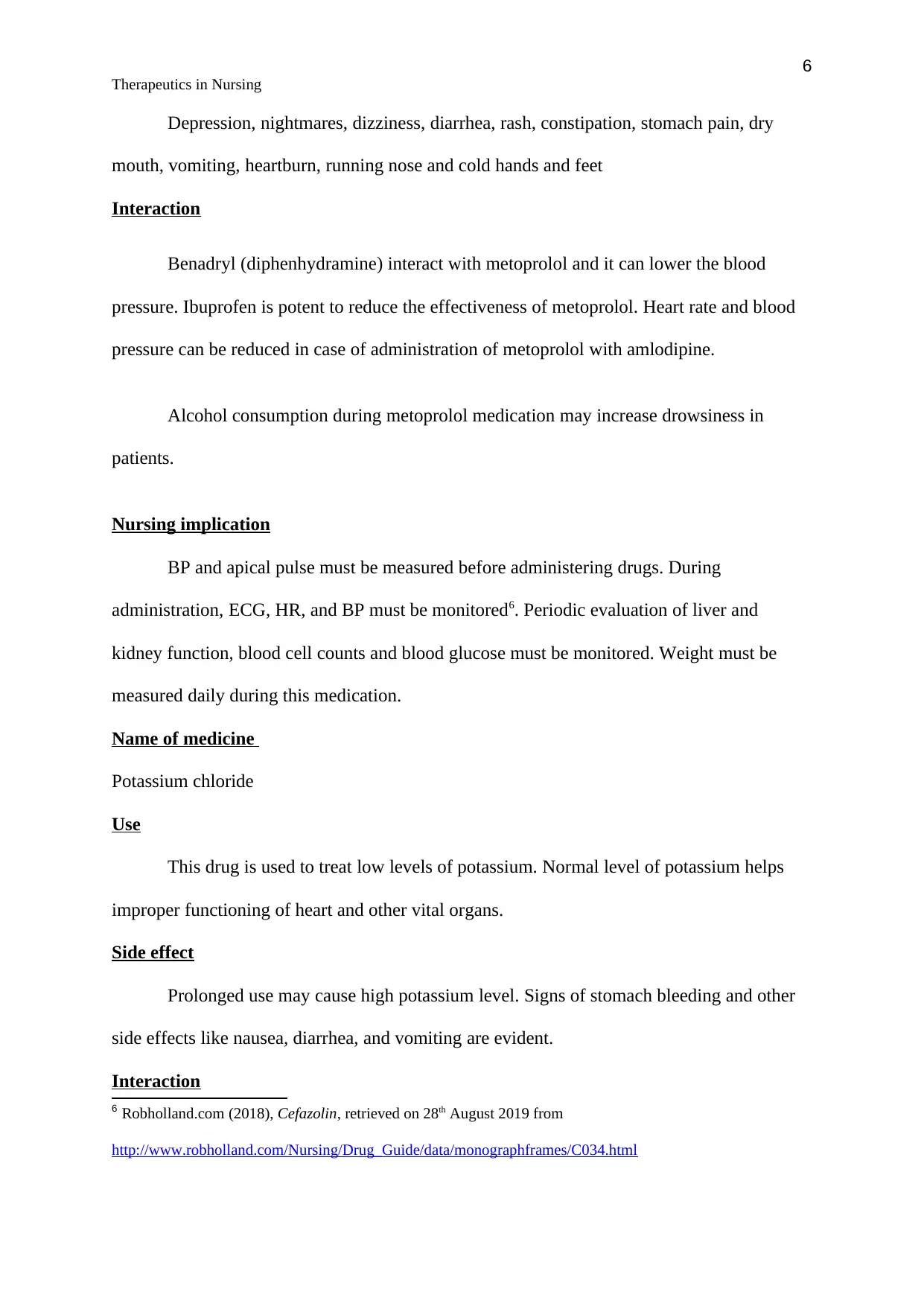
6
Therapeutics in Nursing
Depression, nightmares, dizziness, diarrhea, rash, constipation, stomach pain, dry
mouth, vomiting, heartburn, running nose and cold hands and feet
Interaction
Benadryl (diphenhydramine) interact with metoprolol and it can lower the blood
pressure. Ibuprofen is potent to reduce the effectiveness of metoprolol. Heart rate and blood
pressure can be reduced in case of administration of metoprolol with amlodipine.
Alcohol consumption during metoprolol medication may increase drowsiness in
patients.
Nursing implication
BP and apical pulse must be measured before administering drugs. During
administration, ECG, HR, and BP must be monitored6. Periodic evaluation of liver and
kidney function, blood cell counts and blood glucose must be monitored. Weight must be
measured daily during this medication.
Name of medicine
Potassium chloride
Use
This drug is used to treat low levels of potassium. Normal level of potassium helps
improper functioning of heart and other vital organs.
Side effect
Prolonged use may cause high potassium level. Signs of stomach bleeding and other
side effects like nausea, diarrhea, and vomiting are evident.
Interaction
6 Robholland.com (2018), Cefazolin, retrieved on 28th August 2019 from
http://www.robholland.com/Nursing/Drug_Guide/data/monographframes/C034.html
Therapeutics in Nursing
Depression, nightmares, dizziness, diarrhea, rash, constipation, stomach pain, dry
mouth, vomiting, heartburn, running nose and cold hands and feet
Interaction
Benadryl (diphenhydramine) interact with metoprolol and it can lower the blood
pressure. Ibuprofen is potent to reduce the effectiveness of metoprolol. Heart rate and blood
pressure can be reduced in case of administration of metoprolol with amlodipine.
Alcohol consumption during metoprolol medication may increase drowsiness in
patients.
Nursing implication
BP and apical pulse must be measured before administering drugs. During
administration, ECG, HR, and BP must be monitored6. Periodic evaluation of liver and
kidney function, blood cell counts and blood glucose must be monitored. Weight must be
measured daily during this medication.
Name of medicine
Potassium chloride
Use
This drug is used to treat low levels of potassium. Normal level of potassium helps
improper functioning of heart and other vital organs.
Side effect
Prolonged use may cause high potassium level. Signs of stomach bleeding and other
side effects like nausea, diarrhea, and vomiting are evident.
Interaction
6 Robholland.com (2018), Cefazolin, retrieved on 28th August 2019 from
http://www.robholland.com/Nursing/Drug_Guide/data/monographframes/C034.html

7
Therapeutics in Nursing
High potassium foods like spinach, mushrooms, sweet potatoes and others must be
avoided. Combining potassium chloride and ramipril can significantly increase blood
potassium levels. This can cause hyperkalemia, which leads to cardiac arrest.
Nursing implication
Echocardiography should be performed before application of this medicine. A lab test
of serum electrolytes must be performed before implementation of drugs. Heartbeat must be
checked frequently. Irregular heartbeat is the primary symptom of hyperkalemia
Name of medicine
Pantoprazole
Use
It is used to reduce excess acid produced by the stomach.
Side effect
Stomach pain, diarrhea, nausea, joint pain, headache, gas, dizziness, and vomiting
Interaction
Combination of Pantoprazole and atorvastatin may enhance blood levels. Risk of liver
damage can be seen in that case7. Naproxen can influence early release of this drug in the
body. Use of warfarin and Pantoprazole can increase the risk of bleeding.
Nursing implication
7 Simon, N., Finzi, J., Cayla, G., Montalescot, G., Collet, J. P., & Hulot, J. S. (2015). Omeprazole, pantoprazole,
and CYP2C19 effects on clopidogrel pharmacokinetic-pharmacodynamic relationships in stable coronary artery
disease patients. European journal of clinical pharmacology, 71(9), 1059-1066. Retrieved from:
https://www.researchgate.net/profile/Jean-Sebastien_Hulot/publication/
278159517_Omeprazole_pantoprazole_and_CYP2C19_effects_on_clopidogrel_pharmacokinetic-
pharmacodynamic_relationships_in_stable_coronary_artery_disease_patients/links/
55cde7dd08ae6a881380ae16/Omeprazole-pantoprazole-and-CYP2C19-effects-on-clopidogrel-pharmacokinetic-
pharmacodynamic-relationships-in-stable-coronary-artery-disease-patients.pdf
Therapeutics in Nursing
High potassium foods like spinach, mushrooms, sweet potatoes and others must be
avoided. Combining potassium chloride and ramipril can significantly increase blood
potassium levels. This can cause hyperkalemia, which leads to cardiac arrest.
Nursing implication
Echocardiography should be performed before application of this medicine. A lab test
of serum electrolytes must be performed before implementation of drugs. Heartbeat must be
checked frequently. Irregular heartbeat is the primary symptom of hyperkalemia
Name of medicine
Pantoprazole
Use
It is used to reduce excess acid produced by the stomach.
Side effect
Stomach pain, diarrhea, nausea, joint pain, headache, gas, dizziness, and vomiting
Interaction
Combination of Pantoprazole and atorvastatin may enhance blood levels. Risk of liver
damage can be seen in that case7. Naproxen can influence early release of this drug in the
body. Use of warfarin and Pantoprazole can increase the risk of bleeding.
Nursing implication
7 Simon, N., Finzi, J., Cayla, G., Montalescot, G., Collet, J. P., & Hulot, J. S. (2015). Omeprazole, pantoprazole,
and CYP2C19 effects on clopidogrel pharmacokinetic-pharmacodynamic relationships in stable coronary artery
disease patients. European journal of clinical pharmacology, 71(9), 1059-1066. Retrieved from:
https://www.researchgate.net/profile/Jean-Sebastien_Hulot/publication/
278159517_Omeprazole_pantoprazole_and_CYP2C19_effects_on_clopidogrel_pharmacokinetic-
pharmacodynamic_relationships_in_stable_coronary_artery_disease_patients/links/
55cde7dd08ae6a881380ae16/Omeprazole-pantoprazole-and-CYP2C19-effects-on-clopidogrel-pharmacokinetic-
pharmacodynamic-relationships-in-stable-coronary-artery-disease-patients.pdf
Paraphrase This Document
Need a fresh take? Get an instant paraphrase of this document with our AI Paraphraser
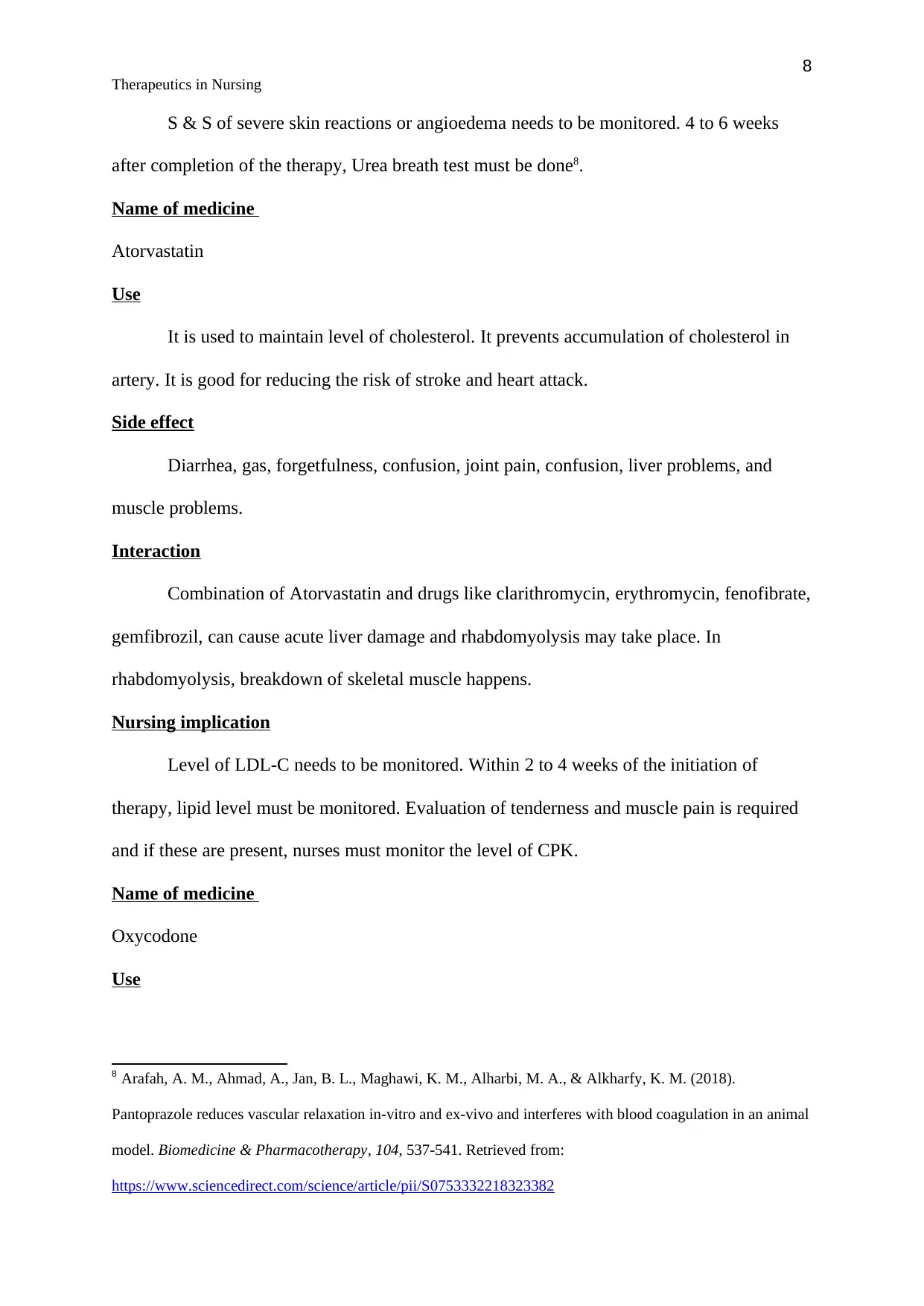
8
Therapeutics in Nursing
S & S of severe skin reactions or angioedema needs to be monitored. 4 to 6 weeks
after completion of the therapy, Urea breath test must be done8.
Name of medicine
Atorvastatin
Use
It is used to maintain level of cholesterol. It prevents accumulation of cholesterol in
artery. It is good for reducing the risk of stroke and heart attack.
Side effect
Diarrhea, gas, forgetfulness, confusion, joint pain, confusion, liver problems, and
muscle problems.
Interaction
Combination of Atorvastatin and drugs like clarithromycin, erythromycin, fenofibrate,
gemfibrozil, can cause acute liver damage and rhabdomyolysis may take place. In
rhabdomyolysis, breakdown of skeletal muscle happens.
Nursing implication
Level of LDL-C needs to be monitored. Within 2 to 4 weeks of the initiation of
therapy, lipid level must be monitored. Evaluation of tenderness and muscle pain is required
and if these are present, nurses must monitor the level of CPK.
Name of medicine
Oxycodone
Use
8 Arafah, A. M., Ahmad, A., Jan, B. L., Maghawi, K. M., Alharbi, M. A., & Alkharfy, K. M. (2018).
Pantoprazole reduces vascular relaxation in-vitro and ex-vivo and interferes with blood coagulation in an animal
model. Biomedicine & Pharmacotherapy, 104, 537-541. Retrieved from:
https://www.sciencedirect.com/science/article/pii/S0753332218323382
Therapeutics in Nursing
S & S of severe skin reactions or angioedema needs to be monitored. 4 to 6 weeks
after completion of the therapy, Urea breath test must be done8.
Name of medicine
Atorvastatin
Use
It is used to maintain level of cholesterol. It prevents accumulation of cholesterol in
artery. It is good for reducing the risk of stroke and heart attack.
Side effect
Diarrhea, gas, forgetfulness, confusion, joint pain, confusion, liver problems, and
muscle problems.
Interaction
Combination of Atorvastatin and drugs like clarithromycin, erythromycin, fenofibrate,
gemfibrozil, can cause acute liver damage and rhabdomyolysis may take place. In
rhabdomyolysis, breakdown of skeletal muscle happens.
Nursing implication
Level of LDL-C needs to be monitored. Within 2 to 4 weeks of the initiation of
therapy, lipid level must be monitored. Evaluation of tenderness and muscle pain is required
and if these are present, nurses must monitor the level of CPK.
Name of medicine
Oxycodone
Use
8 Arafah, A. M., Ahmad, A., Jan, B. L., Maghawi, K. M., Alharbi, M. A., & Alkharfy, K. M. (2018).
Pantoprazole reduces vascular relaxation in-vitro and ex-vivo and interferes with blood coagulation in an animal
model. Biomedicine & Pharmacotherapy, 104, 537-541. Retrieved from:
https://www.sciencedirect.com/science/article/pii/S0753332218323382
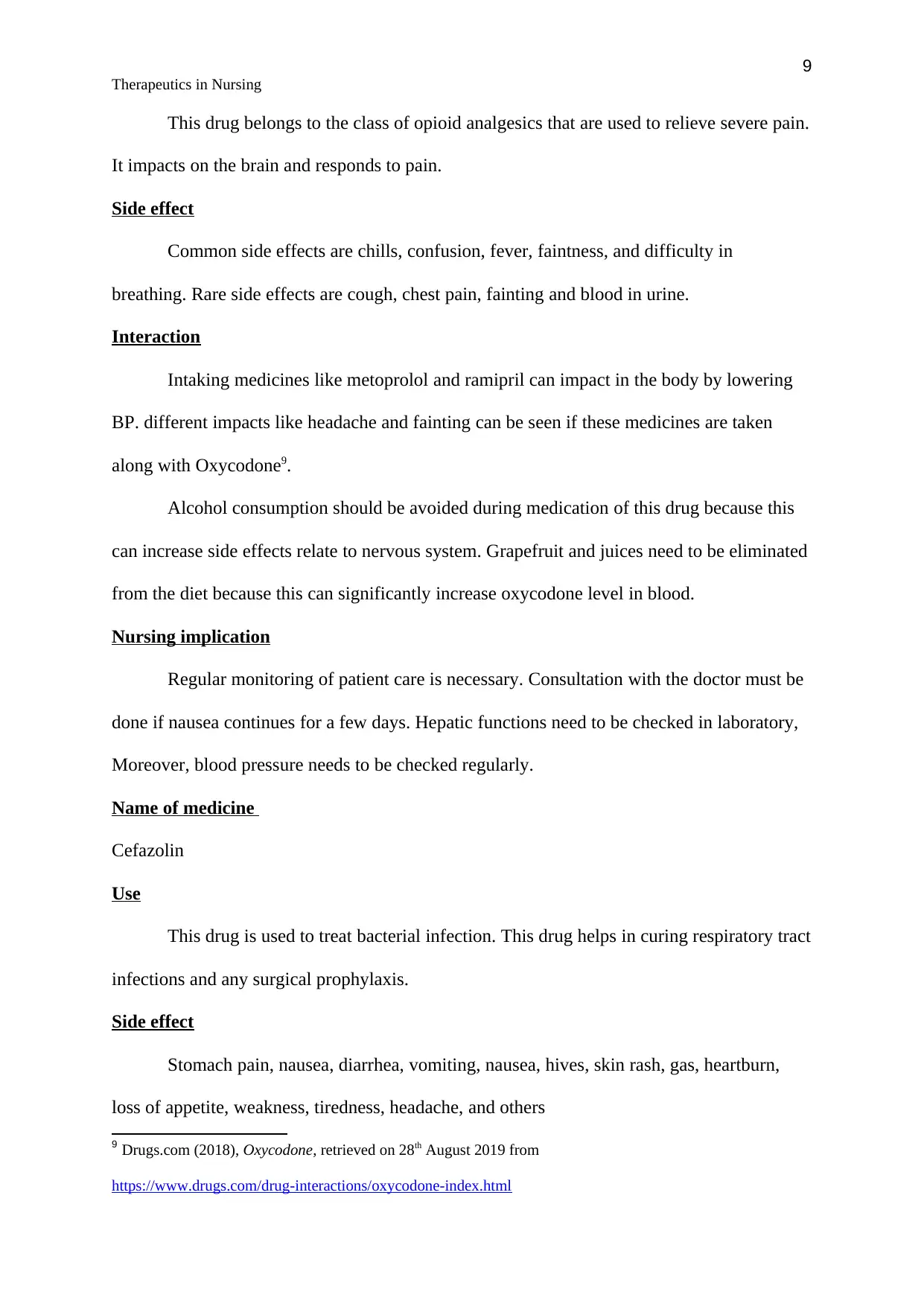
9
Therapeutics in Nursing
This drug belongs to the class of opioid analgesics that are used to relieve severe pain.
It impacts on the brain and responds to pain.
Side effect
Common side effects are chills, confusion, fever, faintness, and difficulty in
breathing. Rare side effects are cough, chest pain, fainting and blood in urine.
Interaction
Intaking medicines like metoprolol and ramipril can impact in the body by lowering
BP. different impacts like headache and fainting can be seen if these medicines are taken
along with Oxycodone9.
Alcohol consumption should be avoided during medication of this drug because this
can increase side effects relate to nervous system. Grapefruit and juices need to be eliminated
from the diet because this can significantly increase oxycodone level in blood.
Nursing implication
Regular monitoring of patient care is necessary. Consultation with the doctor must be
done if nausea continues for a few days. Hepatic functions need to be checked in laboratory,
Moreover, blood pressure needs to be checked regularly.
Name of medicine
Cefazolin
Use
This drug is used to treat bacterial infection. This drug helps in curing respiratory tract
infections and any surgical prophylaxis.
Side effect
Stomach pain, nausea, diarrhea, vomiting, nausea, hives, skin rash, gas, heartburn,
loss of appetite, weakness, tiredness, headache, and others
9 Drugs.com (2018), Oxycodone, retrieved on 28th August 2019 from
https://www.drugs.com/drug-interactions/oxycodone-index.html
Therapeutics in Nursing
This drug belongs to the class of opioid analgesics that are used to relieve severe pain.
It impacts on the brain and responds to pain.
Side effect
Common side effects are chills, confusion, fever, faintness, and difficulty in
breathing. Rare side effects are cough, chest pain, fainting and blood in urine.
Interaction
Intaking medicines like metoprolol and ramipril can impact in the body by lowering
BP. different impacts like headache and fainting can be seen if these medicines are taken
along with Oxycodone9.
Alcohol consumption should be avoided during medication of this drug because this
can increase side effects relate to nervous system. Grapefruit and juices need to be eliminated
from the diet because this can significantly increase oxycodone level in blood.
Nursing implication
Regular monitoring of patient care is necessary. Consultation with the doctor must be
done if nausea continues for a few days. Hepatic functions need to be checked in laboratory,
Moreover, blood pressure needs to be checked regularly.
Name of medicine
Cefazolin
Use
This drug is used to treat bacterial infection. This drug helps in curing respiratory tract
infections and any surgical prophylaxis.
Side effect
Stomach pain, nausea, diarrhea, vomiting, nausea, hives, skin rash, gas, heartburn,
loss of appetite, weakness, tiredness, headache, and others
9 Drugs.com (2018), Oxycodone, retrieved on 28th August 2019 from
https://www.drugs.com/drug-interactions/oxycodone-index.html
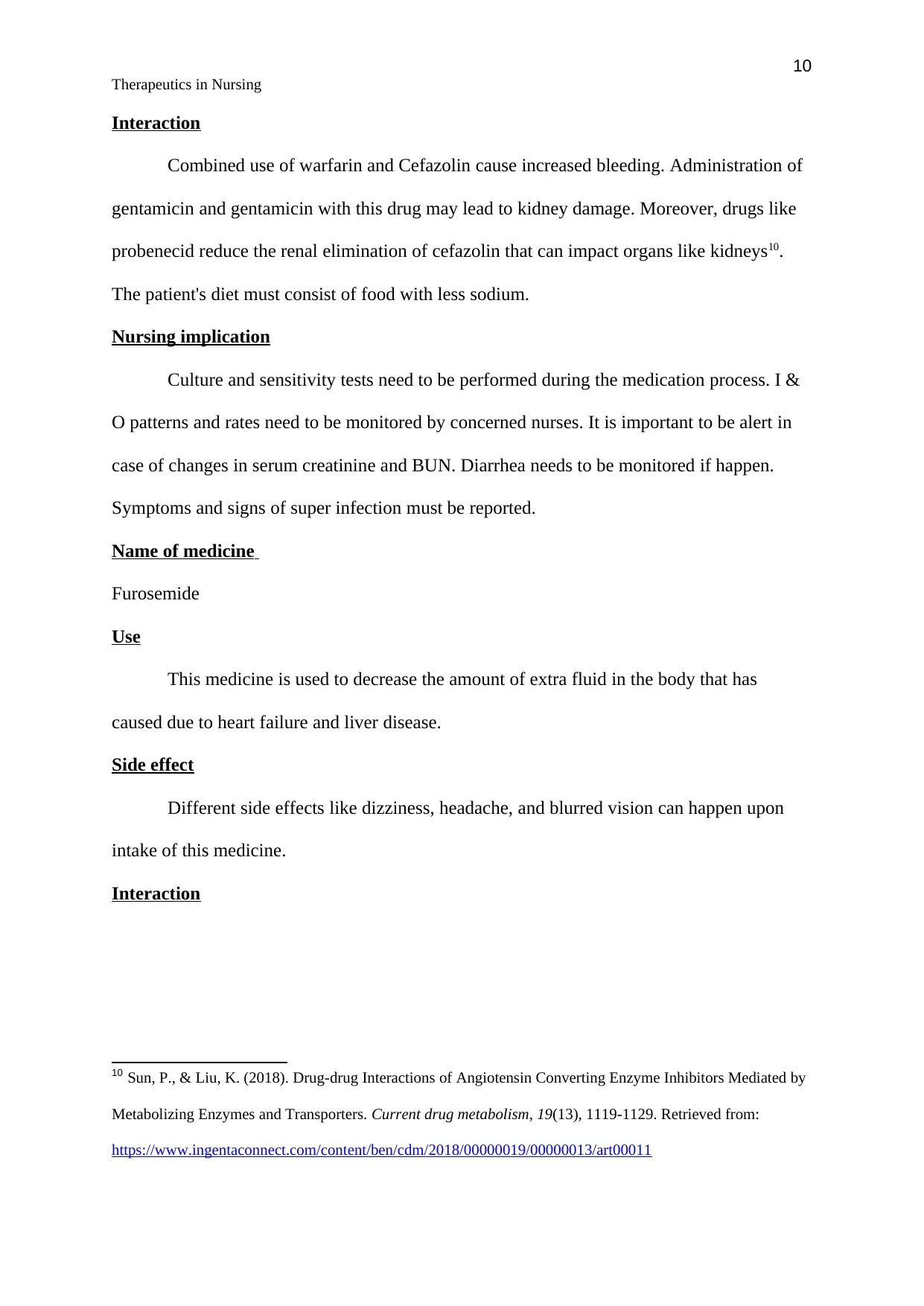
10
Therapeutics in Nursing
Interaction
Combined use of warfarin and Cefazolin cause increased bleeding. Administration of
gentamicin and gentamicin with this drug may lead to kidney damage. Moreover, drugs like
probenecid reduce the renal elimination of cefazolin that can impact organs like kidneys10.
The patient's diet must consist of food with less sodium.
Nursing implication
Culture and sensitivity tests need to be performed during the medication process. I &
O patterns and rates need to be monitored by concerned nurses. It is important to be alert in
case of changes in serum creatinine and BUN. Diarrhea needs to be monitored if happen.
Symptoms and signs of super infection must be reported.
Name of medicine
Furosemide
Use
This medicine is used to decrease the amount of extra fluid in the body that has
caused due to heart failure and liver disease.
Side effect
Different side effects like dizziness, headache, and blurred vision can happen upon
intake of this medicine.
Interaction
10 Sun, P., & Liu, K. (2018). Drug-drug Interactions of Angiotensin Converting Enzyme Inhibitors Mediated by
Metabolizing Enzymes and Transporters. Current drug metabolism, 19(13), 1119-1129. Retrieved from:
https://www.ingentaconnect.com/content/ben/cdm/2018/00000019/00000013/art00011
Therapeutics in Nursing
Interaction
Combined use of warfarin and Cefazolin cause increased bleeding. Administration of
gentamicin and gentamicin with this drug may lead to kidney damage. Moreover, drugs like
probenecid reduce the renal elimination of cefazolin that can impact organs like kidneys10.
The patient's diet must consist of food with less sodium.
Nursing implication
Culture and sensitivity tests need to be performed during the medication process. I &
O patterns and rates need to be monitored by concerned nurses. It is important to be alert in
case of changes in serum creatinine and BUN. Diarrhea needs to be monitored if happen.
Symptoms and signs of super infection must be reported.
Name of medicine
Furosemide
Use
This medicine is used to decrease the amount of extra fluid in the body that has
caused due to heart failure and liver disease.
Side effect
Different side effects like dizziness, headache, and blurred vision can happen upon
intake of this medicine.
Interaction
10 Sun, P., & Liu, K. (2018). Drug-drug Interactions of Angiotensin Converting Enzyme Inhibitors Mediated by
Metabolizing Enzymes and Transporters. Current drug metabolism, 19(13), 1119-1129. Retrieved from:
https://www.ingentaconnect.com/content/ben/cdm/2018/00000019/00000013/art00011
Secure Best Marks with AI Grader
Need help grading? Try our AI Grader for instant feedback on your assignments.
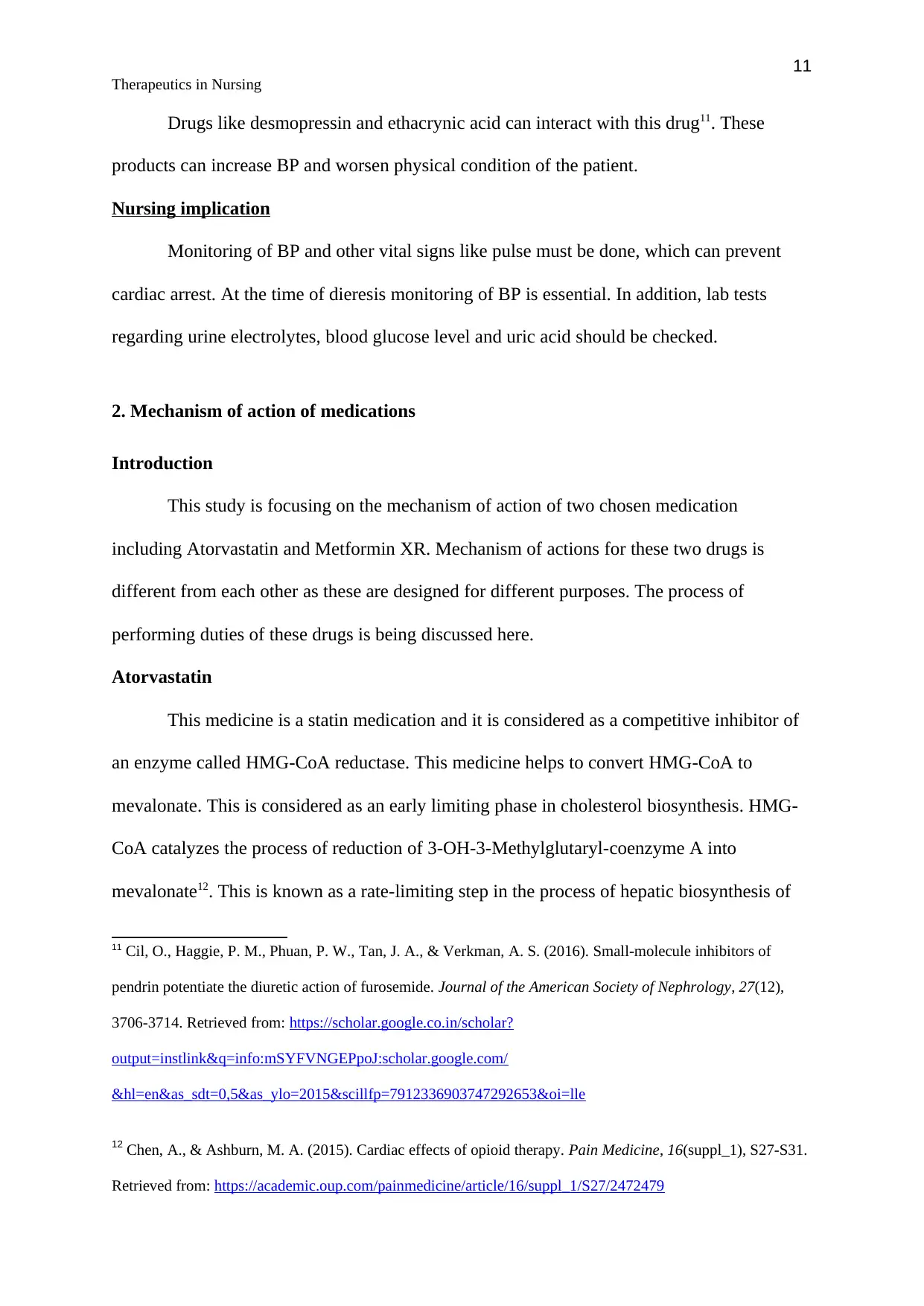
11
Therapeutics in Nursing
Drugs like desmopressin and ethacrynic acid can interact with this drug11. These
products can increase BP and worsen physical condition of the patient.
Nursing implication
Monitoring of BP and other vital signs like pulse must be done, which can prevent
cardiac arrest. At the time of dieresis monitoring of BP is essential. In addition, lab tests
regarding urine electrolytes, blood glucose level and uric acid should be checked.
2. Mechanism of action of medications
Introduction
This study is focusing on the mechanism of action of two chosen medication
including Atorvastatin and Metformin XR. Mechanism of actions for these two drugs is
different from each other as these are designed for different purposes. The process of
performing duties of these drugs is being discussed here.
Atorvastatin
This medicine is a statin medication and it is considered as a competitive inhibitor of
an enzyme called HMG-CoA reductase. This medicine helps to convert HMG-CoA to
mevalonate. This is considered as an early limiting phase in cholesterol biosynthesis. HMG-
CoA catalyzes the process of reduction of 3-OH-3-Methylglutaryl-coenzyme A into
mevalonate12. This is known as a rate-limiting step in the process of hepatic biosynthesis of
11 Cil, O., Haggie, P. M., Phuan, P. W., Tan, J. A., & Verkman, A. S. (2016). Small-molecule inhibitors of
pendrin potentiate the diuretic action of furosemide. Journal of the American Society of Nephrology, 27(12),
3706-3714. Retrieved from: https://scholar.google.co.in/scholar?
output=instlink&q=info:mSYFVNGEPpoJ:scholar.google.com/
&hl=en&as_sdt=0,5&as_ylo=2015&scillfp=7912336903747292653&oi=lle
12 Chen, A., & Ashburn, M. A. (2015). Cardiac effects of opioid therapy. Pain Medicine, 16(suppl_1), S27-S31.
Retrieved from: https://academic.oup.com/painmedicine/article/16/suppl_1/S27/2472479
Therapeutics in Nursing
Drugs like desmopressin and ethacrynic acid can interact with this drug11. These
products can increase BP and worsen physical condition of the patient.
Nursing implication
Monitoring of BP and other vital signs like pulse must be done, which can prevent
cardiac arrest. At the time of dieresis monitoring of BP is essential. In addition, lab tests
regarding urine electrolytes, blood glucose level and uric acid should be checked.
2. Mechanism of action of medications
Introduction
This study is focusing on the mechanism of action of two chosen medication
including Atorvastatin and Metformin XR. Mechanism of actions for these two drugs is
different from each other as these are designed for different purposes. The process of
performing duties of these drugs is being discussed here.
Atorvastatin
This medicine is a statin medication and it is considered as a competitive inhibitor of
an enzyme called HMG-CoA reductase. This medicine helps to convert HMG-CoA to
mevalonate. This is considered as an early limiting phase in cholesterol biosynthesis. HMG-
CoA catalyzes the process of reduction of 3-OH-3-Methylglutaryl-coenzyme A into
mevalonate12. This is known as a rate-limiting step in the process of hepatic biosynthesis of
11 Cil, O., Haggie, P. M., Phuan, P. W., Tan, J. A., & Verkman, A. S. (2016). Small-molecule inhibitors of
pendrin potentiate the diuretic action of furosemide. Journal of the American Society of Nephrology, 27(12),
3706-3714. Retrieved from: https://scholar.google.co.in/scholar?
output=instlink&q=info:mSYFVNGEPpoJ:scholar.google.com/
&hl=en&as_sdt=0,5&as_ylo=2015&scillfp=7912336903747292653&oi=lle
12 Chen, A., & Ashburn, M. A. (2015). Cardiac effects of opioid therapy. Pain Medicine, 16(suppl_1), S27-S31.
Retrieved from: https://academic.oup.com/painmedicine/article/16/suppl_1/S27/2472479
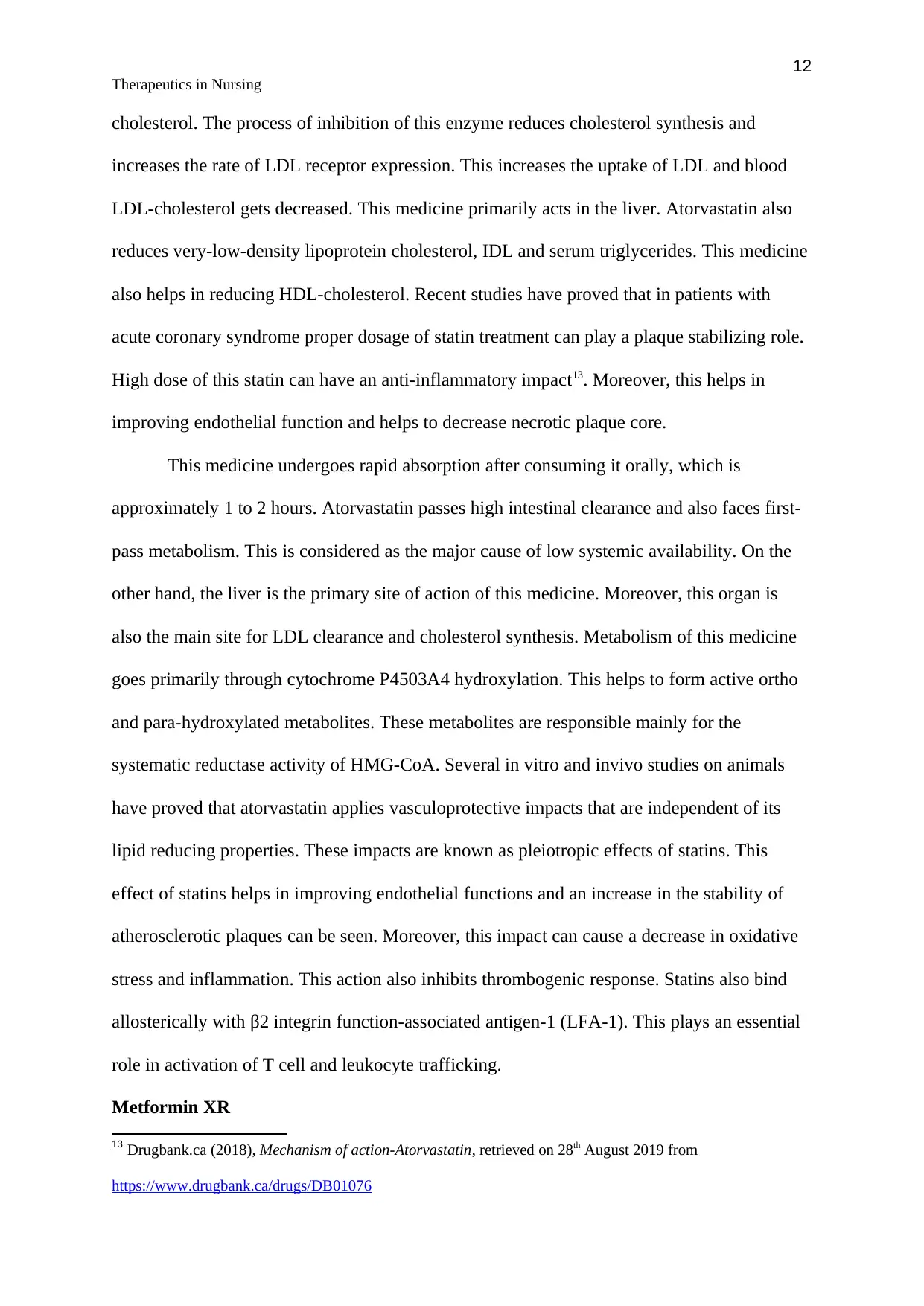
12
Therapeutics in Nursing
cholesterol. The process of inhibition of this enzyme reduces cholesterol synthesis and
increases the rate of LDL receptor expression. This increases the uptake of LDL and blood
LDL-cholesterol gets decreased. This medicine primarily acts in the liver. Atorvastatin also
reduces very-low-density lipoprotein cholesterol, IDL and serum triglycerides. This medicine
also helps in reducing HDL-cholesterol. Recent studies have proved that in patients with
acute coronary syndrome proper dosage of statin treatment can play a plaque stabilizing role.
High dose of this statin can have an anti-inflammatory impact13. Moreover, this helps in
improving endothelial function and helps to decrease necrotic plaque core.
This medicine undergoes rapid absorption after consuming it orally, which is
approximately 1 to 2 hours. Atorvastatin passes high intestinal clearance and also faces first-
pass metabolism. This is considered as the major cause of low systemic availability. On the
other hand, the liver is the primary site of action of this medicine. Moreover, this organ is
also the main site for LDL clearance and cholesterol synthesis. Metabolism of this medicine
goes primarily through cytochrome P4503A4 hydroxylation. This helps to form active ortho
and para-hydroxylated metabolites. These metabolites are responsible mainly for the
systematic reductase activity of HMG-CoA. Several in vitro and invivo studies on animals
have proved that atorvastatin applies vasculoprotective impacts that are independent of its
lipid reducing properties. These impacts are known as pleiotropic effects of statins. This
effect of statins helps in improving endothelial functions and an increase in the stability of
atherosclerotic plaques can be seen. Moreover, this impact can cause a decrease in oxidative
stress and inflammation. This action also inhibits thrombogenic response. Statins also bind
allosterically with β2 integrin function-associated antigen-1 (LFA-1). This plays an essential
role in activation of T cell and leukocyte trafficking.
Metformin XR
13 Drugbank.ca (2018), Mechanism of action-Atorvastatin, retrieved on 28th August 2019 from
https://www.drugbank.ca/drugs/DB01076
Therapeutics in Nursing
cholesterol. The process of inhibition of this enzyme reduces cholesterol synthesis and
increases the rate of LDL receptor expression. This increases the uptake of LDL and blood
LDL-cholesterol gets decreased. This medicine primarily acts in the liver. Atorvastatin also
reduces very-low-density lipoprotein cholesterol, IDL and serum triglycerides. This medicine
also helps in reducing HDL-cholesterol. Recent studies have proved that in patients with
acute coronary syndrome proper dosage of statin treatment can play a plaque stabilizing role.
High dose of this statin can have an anti-inflammatory impact13. Moreover, this helps in
improving endothelial function and helps to decrease necrotic plaque core.
This medicine undergoes rapid absorption after consuming it orally, which is
approximately 1 to 2 hours. Atorvastatin passes high intestinal clearance and also faces first-
pass metabolism. This is considered as the major cause of low systemic availability. On the
other hand, the liver is the primary site of action of this medicine. Moreover, this organ is
also the main site for LDL clearance and cholesterol synthesis. Metabolism of this medicine
goes primarily through cytochrome P4503A4 hydroxylation. This helps to form active ortho
and para-hydroxylated metabolites. These metabolites are responsible mainly for the
systematic reductase activity of HMG-CoA. Several in vitro and invivo studies on animals
have proved that atorvastatin applies vasculoprotective impacts that are independent of its
lipid reducing properties. These impacts are known as pleiotropic effects of statins. This
effect of statins helps in improving endothelial functions and an increase in the stability of
atherosclerotic plaques can be seen. Moreover, this impact can cause a decrease in oxidative
stress and inflammation. This action also inhibits thrombogenic response. Statins also bind
allosterically with β2 integrin function-associated antigen-1 (LFA-1). This plays an essential
role in activation of T cell and leukocyte trafficking.
Metformin XR
13 Drugbank.ca (2018), Mechanism of action-Atorvastatin, retrieved on 28th August 2019 from
https://www.drugbank.ca/drugs/DB01076
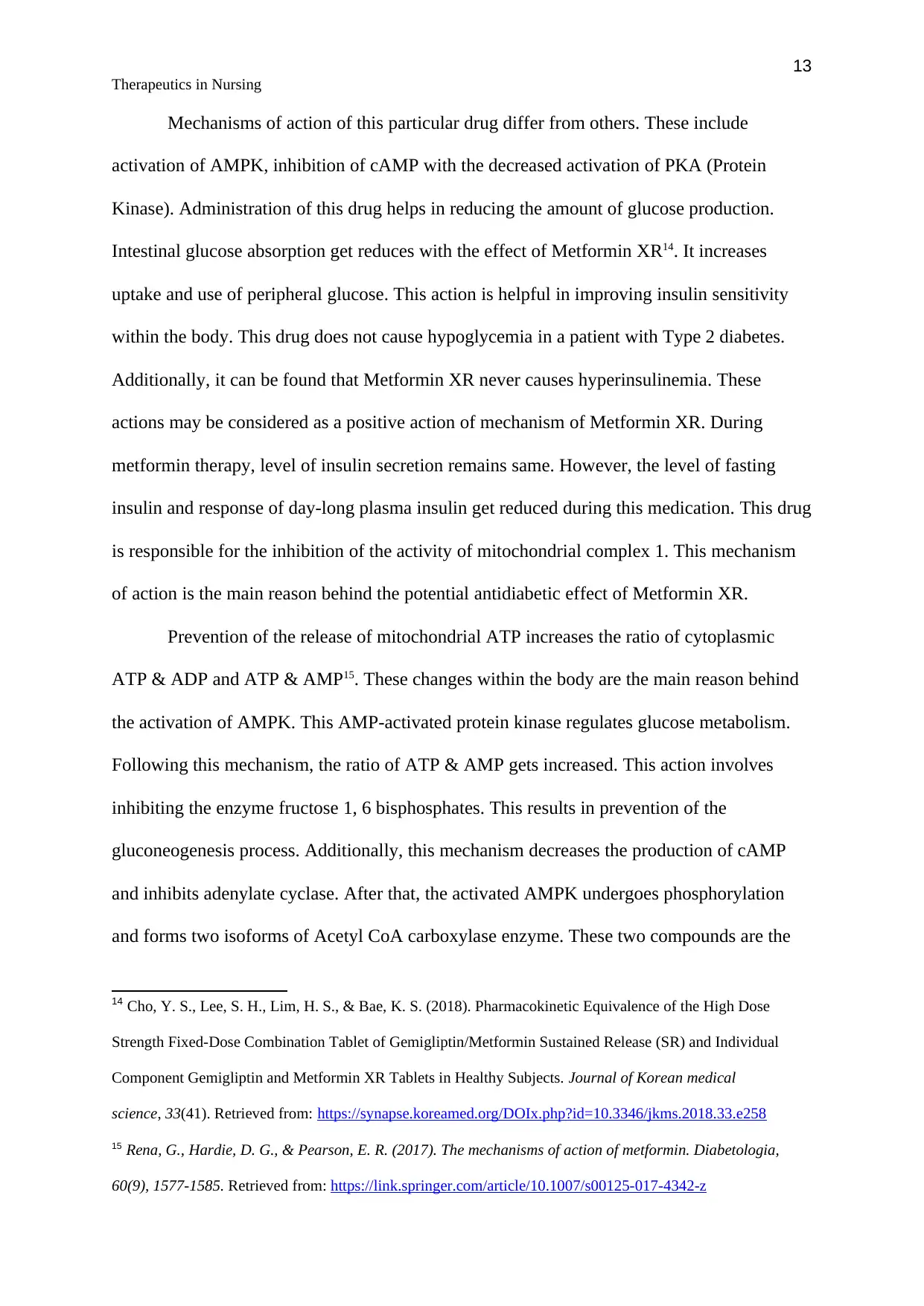
13
Therapeutics in Nursing
Mechanisms of action of this particular drug differ from others. These include
activation of AMPK, inhibition of cAMP with the decreased activation of PKA (Protein
Kinase). Administration of this drug helps in reducing the amount of glucose production.
Intestinal glucose absorption get reduces with the effect of Metformin XR14. It increases
uptake and use of peripheral glucose. This action is helpful in improving insulin sensitivity
within the body. This drug does not cause hypoglycemia in a patient with Type 2 diabetes.
Additionally, it can be found that Metformin XR never causes hyperinsulinemia. These
actions may be considered as a positive action of mechanism of Metformin XR. During
metformin therapy, level of insulin secretion remains same. However, the level of fasting
insulin and response of day-long plasma insulin get reduced during this medication. This drug
is responsible for the inhibition of the activity of mitochondrial complex 1. This mechanism
of action is the main reason behind the potential antidiabetic effect of Metformin XR.
Prevention of the release of mitochondrial ATP increases the ratio of cytoplasmic
ATP & ADP and ATP & AMP15. These changes within the body are the main reason behind
the activation of AMPK. This AMP-activated protein kinase regulates glucose metabolism.
Following this mechanism, the ratio of ATP & AMP gets increased. This action involves
inhibiting the enzyme fructose 1, 6 bisphosphates. This results in prevention of the
gluconeogenesis process. Additionally, this mechanism decreases the production of cAMP
and inhibits adenylate cyclase. After that, the activated AMPK undergoes phosphorylation
and forms two isoforms of Acetyl CoA carboxylase enzyme. These two compounds are the
14 Cho, Y. S., Lee, S. H., Lim, H. S., & Bae, K. S. (2018). Pharmacokinetic Equivalence of the High Dose
Strength Fixed-Dose Combination Tablet of Gemigliptin/Metformin Sustained Release (SR) and Individual
Component Gemigliptin and Metformin XR Tablets in Healthy Subjects. Journal of Korean medical
science, 33(41). Retrieved from: https://synapse.koreamed.org/DOIx.php?id=10.3346/jkms.2018.33.e258
15 Rena, G., Hardie, D. G., & Pearson, E. R. (2017). The mechanisms of action of metformin. Diabetologia,
60(9), 1577-1585. Retrieved from: https://link.springer.com/article/10.1007/s00125-017-4342-z
Therapeutics in Nursing
Mechanisms of action of this particular drug differ from others. These include
activation of AMPK, inhibition of cAMP with the decreased activation of PKA (Protein
Kinase). Administration of this drug helps in reducing the amount of glucose production.
Intestinal glucose absorption get reduces with the effect of Metformin XR14. It increases
uptake and use of peripheral glucose. This action is helpful in improving insulin sensitivity
within the body. This drug does not cause hypoglycemia in a patient with Type 2 diabetes.
Additionally, it can be found that Metformin XR never causes hyperinsulinemia. These
actions may be considered as a positive action of mechanism of Metformin XR. During
metformin therapy, level of insulin secretion remains same. However, the level of fasting
insulin and response of day-long plasma insulin get reduced during this medication. This drug
is responsible for the inhibition of the activity of mitochondrial complex 1. This mechanism
of action is the main reason behind the potential antidiabetic effect of Metformin XR.
Prevention of the release of mitochondrial ATP increases the ratio of cytoplasmic
ATP & ADP and ATP & AMP15. These changes within the body are the main reason behind
the activation of AMPK. This AMP-activated protein kinase regulates glucose metabolism.
Following this mechanism, the ratio of ATP & AMP gets increased. This action involves
inhibiting the enzyme fructose 1, 6 bisphosphates. This results in prevention of the
gluconeogenesis process. Additionally, this mechanism decreases the production of cAMP
and inhibits adenylate cyclase. After that, the activated AMPK undergoes phosphorylation
and forms two isoforms of Acetyl CoA carboxylase enzyme. These two compounds are the
14 Cho, Y. S., Lee, S. H., Lim, H. S., & Bae, K. S. (2018). Pharmacokinetic Equivalence of the High Dose
Strength Fixed-Dose Combination Tablet of Gemigliptin/Metformin Sustained Release (SR) and Individual
Component Gemigliptin and Metformin XR Tablets in Healthy Subjects. Journal of Korean medical
science, 33(41). Retrieved from: https://synapse.koreamed.org/DOIx.php?id=10.3346/jkms.2018.33.e258
15 Rena, G., Hardie, D. G., & Pearson, E. R. (2017). The mechanisms of action of metformin. Diabetologia,
60(9), 1577-1585. Retrieved from: https://link.springer.com/article/10.1007/s00125-017-4342-z
Paraphrase This Document
Need a fresh take? Get an instant paraphrase of this document with our AI Paraphraser
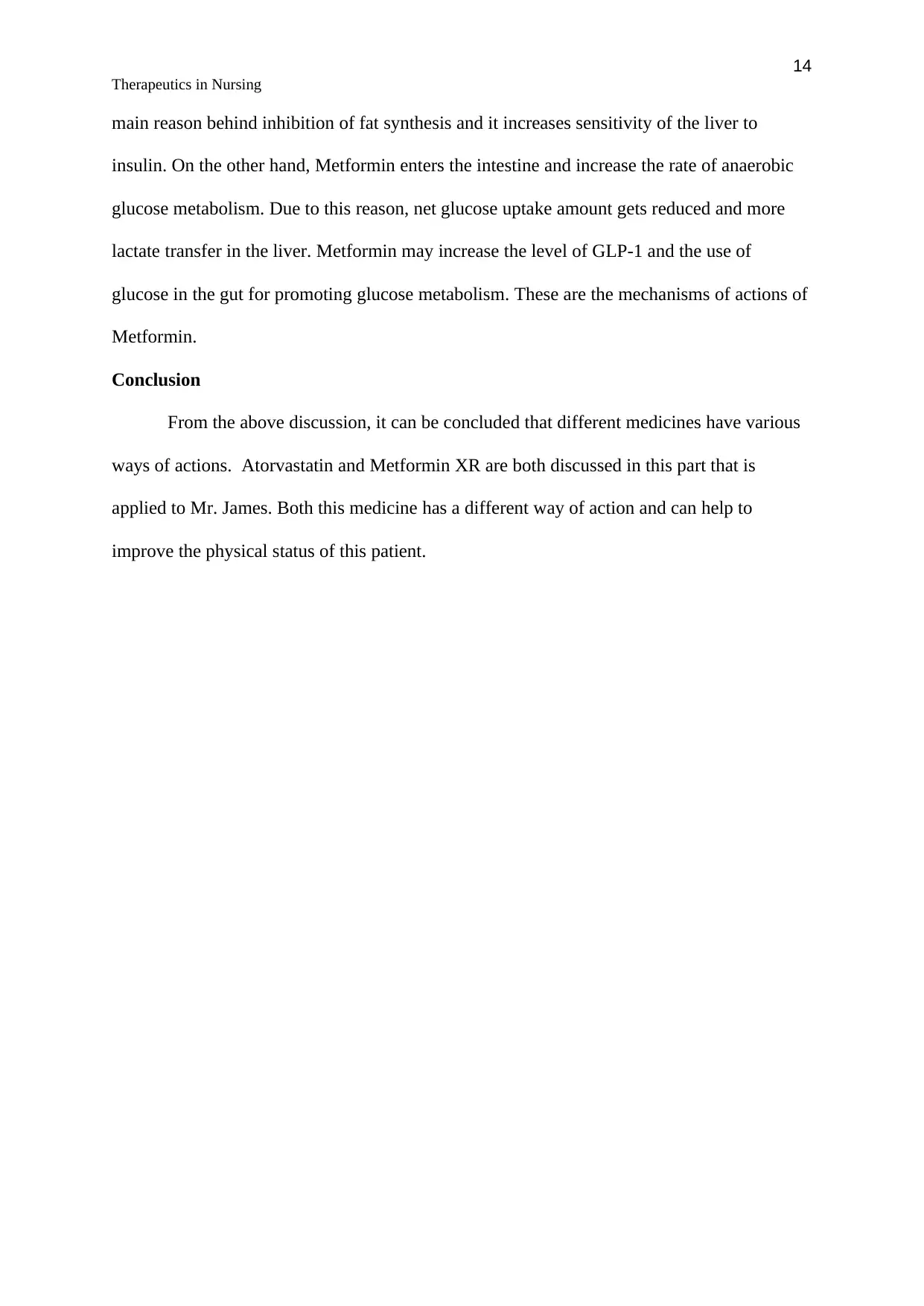
14
Therapeutics in Nursing
main reason behind inhibition of fat synthesis and it increases sensitivity of the liver to
insulin. On the other hand, Metformin enters the intestine and increase the rate of anaerobic
glucose metabolism. Due to this reason, net glucose uptake amount gets reduced and more
lactate transfer in the liver. Metformin may increase the level of GLP-1 and the use of
glucose in the gut for promoting glucose metabolism. These are the mechanisms of actions of
Metformin.
Conclusion
From the above discussion, it can be concluded that different medicines have various
ways of actions. Atorvastatin and Metformin XR are both discussed in this part that is
applied to Mr. James. Both this medicine has a different way of action and can help to
improve the physical status of this patient.
Therapeutics in Nursing
main reason behind inhibition of fat synthesis and it increases sensitivity of the liver to
insulin. On the other hand, Metformin enters the intestine and increase the rate of anaerobic
glucose metabolism. Due to this reason, net glucose uptake amount gets reduced and more
lactate transfer in the liver. Metformin may increase the level of GLP-1 and the use of
glucose in the gut for promoting glucose metabolism. These are the mechanisms of actions of
Metformin.
Conclusion
From the above discussion, it can be concluded that different medicines have various
ways of actions. Atorvastatin and Metformin XR are both discussed in this part that is
applied to Mr. James. Both this medicine has a different way of action and can help to
improve the physical status of this patient.
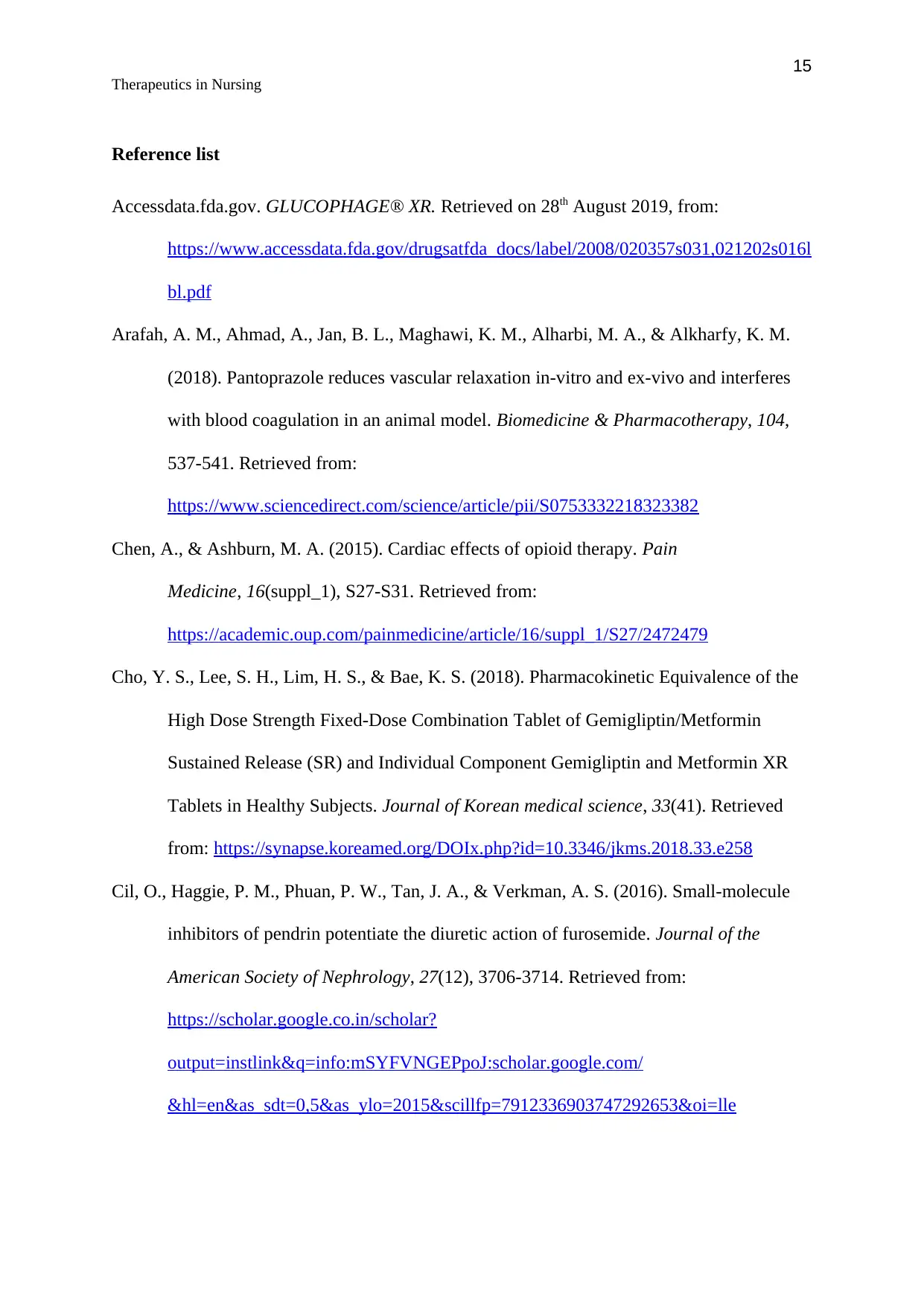
15
Therapeutics in Nursing
Reference list
Accessdata.fda.gov. GLUCOPHAGE® XR. Retrieved on 28th August 2019, from:
https://www.accessdata.fda.gov/drugsatfda_docs/label/2008/020357s031,021202s016l
bl.pdf
Arafah, A. M., Ahmad, A., Jan, B. L., Maghawi, K. M., Alharbi, M. A., & Alkharfy, K. M.
(2018). Pantoprazole reduces vascular relaxation in-vitro and ex-vivo and interferes
with blood coagulation in an animal model. Biomedicine & Pharmacotherapy, 104,
537-541. Retrieved from:
https://www.sciencedirect.com/science/article/pii/S0753332218323382
Chen, A., & Ashburn, M. A. (2015). Cardiac effects of opioid therapy. Pain
Medicine, 16(suppl_1), S27-S31. Retrieved from:
https://academic.oup.com/painmedicine/article/16/suppl_1/S27/2472479
Cho, Y. S., Lee, S. H., Lim, H. S., & Bae, K. S. (2018). Pharmacokinetic Equivalence of the
High Dose Strength Fixed-Dose Combination Tablet of Gemigliptin/Metformin
Sustained Release (SR) and Individual Component Gemigliptin and Metformin XR
Tablets in Healthy Subjects. Journal of Korean medical science, 33(41). Retrieved
from: https://synapse.koreamed.org/DOIx.php?id=10.3346/jkms.2018.33.e258
Cil, O., Haggie, P. M., Phuan, P. W., Tan, J. A., & Verkman, A. S. (2016). Small-molecule
inhibitors of pendrin potentiate the diuretic action of furosemide. Journal of the
American Society of Nephrology, 27(12), 3706-3714. Retrieved from:
https://scholar.google.co.in/scholar?
output=instlink&q=info:mSYFVNGEPpoJ:scholar.google.com/
&hl=en&as_sdt=0,5&as_ylo=2015&scillfp=7912336903747292653&oi=lle
Therapeutics in Nursing
Reference list
Accessdata.fda.gov. GLUCOPHAGE® XR. Retrieved on 28th August 2019, from:
https://www.accessdata.fda.gov/drugsatfda_docs/label/2008/020357s031,021202s016l
bl.pdf
Arafah, A. M., Ahmad, A., Jan, B. L., Maghawi, K. M., Alharbi, M. A., & Alkharfy, K. M.
(2018). Pantoprazole reduces vascular relaxation in-vitro and ex-vivo and interferes
with blood coagulation in an animal model. Biomedicine & Pharmacotherapy, 104,
537-541. Retrieved from:
https://www.sciencedirect.com/science/article/pii/S0753332218323382
Chen, A., & Ashburn, M. A. (2015). Cardiac effects of opioid therapy. Pain
Medicine, 16(suppl_1), S27-S31. Retrieved from:
https://academic.oup.com/painmedicine/article/16/suppl_1/S27/2472479
Cho, Y. S., Lee, S. H., Lim, H. S., & Bae, K. S. (2018). Pharmacokinetic Equivalence of the
High Dose Strength Fixed-Dose Combination Tablet of Gemigliptin/Metformin
Sustained Release (SR) and Individual Component Gemigliptin and Metformin XR
Tablets in Healthy Subjects. Journal of Korean medical science, 33(41). Retrieved
from: https://synapse.koreamed.org/DOIx.php?id=10.3346/jkms.2018.33.e258
Cil, O., Haggie, P. M., Phuan, P. W., Tan, J. A., & Verkman, A. S. (2016). Small-molecule
inhibitors of pendrin potentiate the diuretic action of furosemide. Journal of the
American Society of Nephrology, 27(12), 3706-3714. Retrieved from:
https://scholar.google.co.in/scholar?
output=instlink&q=info:mSYFVNGEPpoJ:scholar.google.com/
&hl=en&as_sdt=0,5&as_ylo=2015&scillfp=7912336903747292653&oi=lle
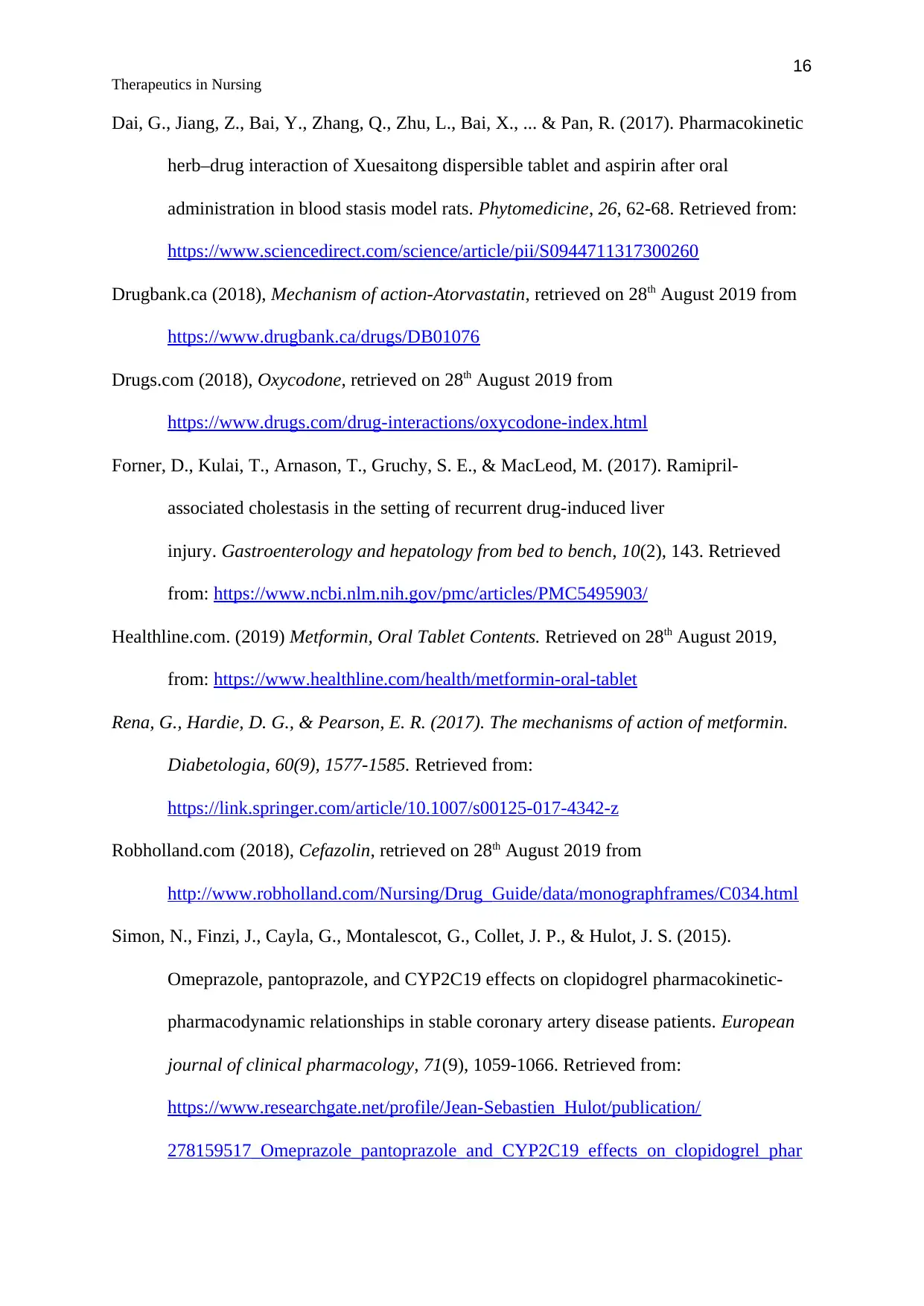
16
Therapeutics in Nursing
Dai, G., Jiang, Z., Bai, Y., Zhang, Q., Zhu, L., Bai, X., ... & Pan, R. (2017). Pharmacokinetic
herb–drug interaction of Xuesaitong dispersible tablet and aspirin after oral
administration in blood stasis model rats. Phytomedicine, 26, 62-68. Retrieved from:
https://www.sciencedirect.com/science/article/pii/S0944711317300260
Drugbank.ca (2018), Mechanism of action-Atorvastatin, retrieved on 28th August 2019 from
https://www.drugbank.ca/drugs/DB01076
Drugs.com (2018), Oxycodone, retrieved on 28th August 2019 from
https://www.drugs.com/drug-interactions/oxycodone-index.html
Forner, D., Kulai, T., Arnason, T., Gruchy, S. E., & MacLeod, M. (2017). Ramipril-
associated cholestasis in the setting of recurrent drug-induced liver
injury. Gastroenterology and hepatology from bed to bench, 10(2), 143. Retrieved
from: https://www.ncbi.nlm.nih.gov/pmc/articles/PMC5495903/
Healthline.com. (2019) Metformin, Oral Tablet Contents. Retrieved on 28th August 2019,
from: https://www.healthline.com/health/metformin-oral-tablet
Rena, G., Hardie, D. G., & Pearson, E. R. (2017). The mechanisms of action of metformin.
Diabetologia, 60(9), 1577-1585. Retrieved from:
https://link.springer.com/article/10.1007/s00125-017-4342-z
Robholland.com (2018), Cefazolin, retrieved on 28th August 2019 from
http://www.robholland.com/Nursing/Drug_Guide/data/monographframes/C034.html
Simon, N., Finzi, J., Cayla, G., Montalescot, G., Collet, J. P., & Hulot, J. S. (2015).
Omeprazole, pantoprazole, and CYP2C19 effects on clopidogrel pharmacokinetic-
pharmacodynamic relationships in stable coronary artery disease patients. European
journal of clinical pharmacology, 71(9), 1059-1066. Retrieved from:
https://www.researchgate.net/profile/Jean-Sebastien_Hulot/publication/
278159517_Omeprazole_pantoprazole_and_CYP2C19_effects_on_clopidogrel_phar
Therapeutics in Nursing
Dai, G., Jiang, Z., Bai, Y., Zhang, Q., Zhu, L., Bai, X., ... & Pan, R. (2017). Pharmacokinetic
herb–drug interaction of Xuesaitong dispersible tablet and aspirin after oral
administration in blood stasis model rats. Phytomedicine, 26, 62-68. Retrieved from:
https://www.sciencedirect.com/science/article/pii/S0944711317300260
Drugbank.ca (2018), Mechanism of action-Atorvastatin, retrieved on 28th August 2019 from
https://www.drugbank.ca/drugs/DB01076
Drugs.com (2018), Oxycodone, retrieved on 28th August 2019 from
https://www.drugs.com/drug-interactions/oxycodone-index.html
Forner, D., Kulai, T., Arnason, T., Gruchy, S. E., & MacLeod, M. (2017). Ramipril-
associated cholestasis in the setting of recurrent drug-induced liver
injury. Gastroenterology and hepatology from bed to bench, 10(2), 143. Retrieved
from: https://www.ncbi.nlm.nih.gov/pmc/articles/PMC5495903/
Healthline.com. (2019) Metformin, Oral Tablet Contents. Retrieved on 28th August 2019,
from: https://www.healthline.com/health/metformin-oral-tablet
Rena, G., Hardie, D. G., & Pearson, E. R. (2017). The mechanisms of action of metformin.
Diabetologia, 60(9), 1577-1585. Retrieved from:
https://link.springer.com/article/10.1007/s00125-017-4342-z
Robholland.com (2018), Cefazolin, retrieved on 28th August 2019 from
http://www.robholland.com/Nursing/Drug_Guide/data/monographframes/C034.html
Simon, N., Finzi, J., Cayla, G., Montalescot, G., Collet, J. P., & Hulot, J. S. (2015).
Omeprazole, pantoprazole, and CYP2C19 effects on clopidogrel pharmacokinetic-
pharmacodynamic relationships in stable coronary artery disease patients. European
journal of clinical pharmacology, 71(9), 1059-1066. Retrieved from:
https://www.researchgate.net/profile/Jean-Sebastien_Hulot/publication/
278159517_Omeprazole_pantoprazole_and_CYP2C19_effects_on_clopidogrel_phar
Secure Best Marks with AI Grader
Need help grading? Try our AI Grader for instant feedback on your assignments.
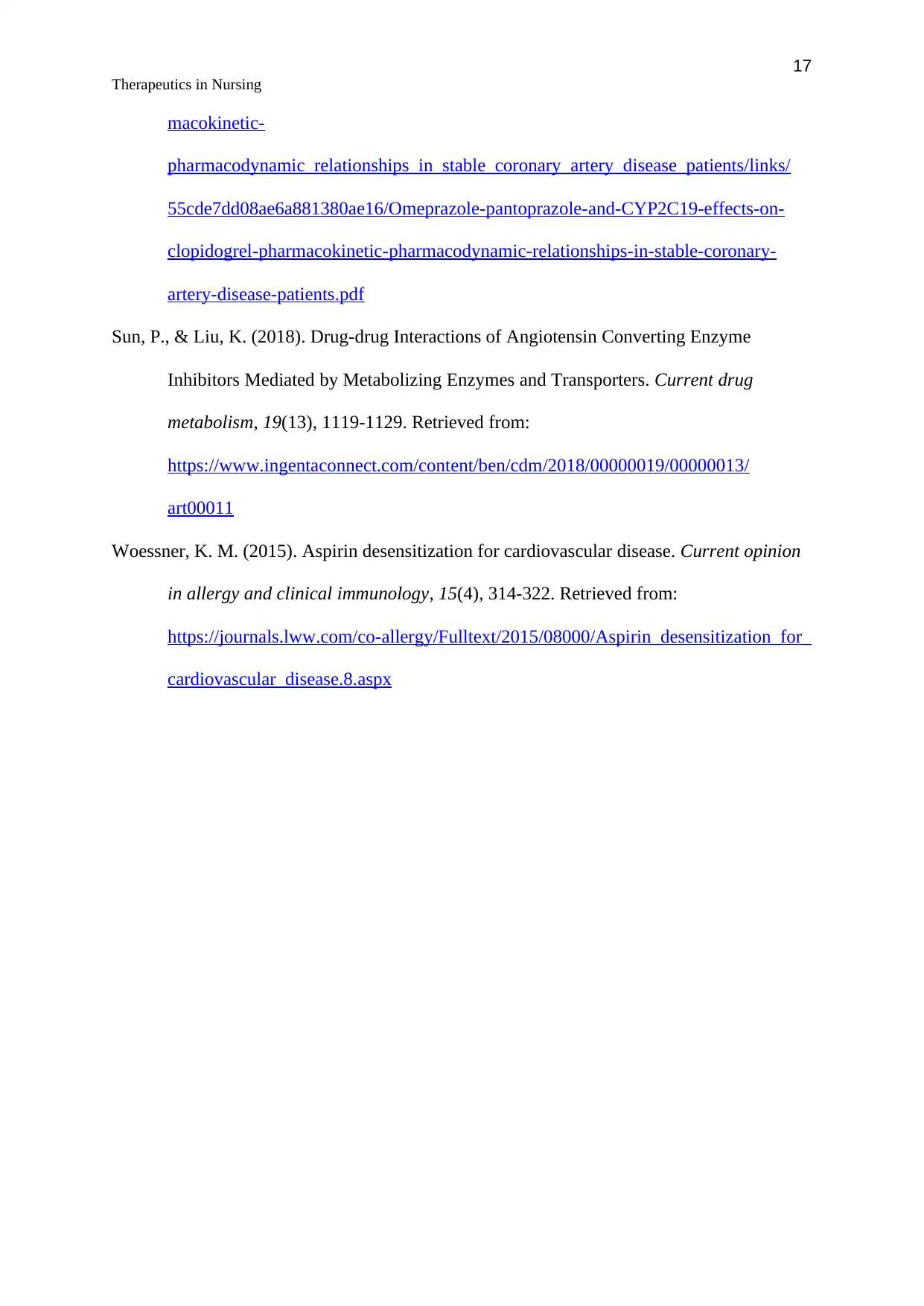
17
Therapeutics in Nursing
macokinetic-
pharmacodynamic_relationships_in_stable_coronary_artery_disease_patients/links/
55cde7dd08ae6a881380ae16/Omeprazole-pantoprazole-and-CYP2C19-effects-on-
clopidogrel-pharmacokinetic-pharmacodynamic-relationships-in-stable-coronary-
artery-disease-patients.pdf
Sun, P., & Liu, K. (2018). Drug-drug Interactions of Angiotensin Converting Enzyme
Inhibitors Mediated by Metabolizing Enzymes and Transporters. Current drug
metabolism, 19(13), 1119-1129. Retrieved from:
https://www.ingentaconnect.com/content/ben/cdm/2018/00000019/00000013/
art00011
Woessner, K. M. (2015). Aspirin desensitization for cardiovascular disease. Current opinion
in allergy and clinical immunology, 15(4), 314-322. Retrieved from:
https://journals.lww.com/co-allergy/Fulltext/2015/08000/Aspirin_desensitization_for_
cardiovascular_disease.8.aspx
Therapeutics in Nursing
macokinetic-
pharmacodynamic_relationships_in_stable_coronary_artery_disease_patients/links/
55cde7dd08ae6a881380ae16/Omeprazole-pantoprazole-and-CYP2C19-effects-on-
clopidogrel-pharmacokinetic-pharmacodynamic-relationships-in-stable-coronary-
artery-disease-patients.pdf
Sun, P., & Liu, K. (2018). Drug-drug Interactions of Angiotensin Converting Enzyme
Inhibitors Mediated by Metabolizing Enzymes and Transporters. Current drug
metabolism, 19(13), 1119-1129. Retrieved from:
https://www.ingentaconnect.com/content/ben/cdm/2018/00000019/00000013/
art00011
Woessner, K. M. (2015). Aspirin desensitization for cardiovascular disease. Current opinion
in allergy and clinical immunology, 15(4), 314-322. Retrieved from:
https://journals.lww.com/co-allergy/Fulltext/2015/08000/Aspirin_desensitization_for_
cardiovascular_disease.8.aspx
1 out of 17
Related Documents
Your All-in-One AI-Powered Toolkit for Academic Success.
+13062052269
info@desklib.com
Available 24*7 on WhatsApp / Email
![[object Object]](/_next/static/media/star-bottom.7253800d.svg)
Unlock your academic potential
© 2024 | Zucol Services PVT LTD | All rights reserved.





